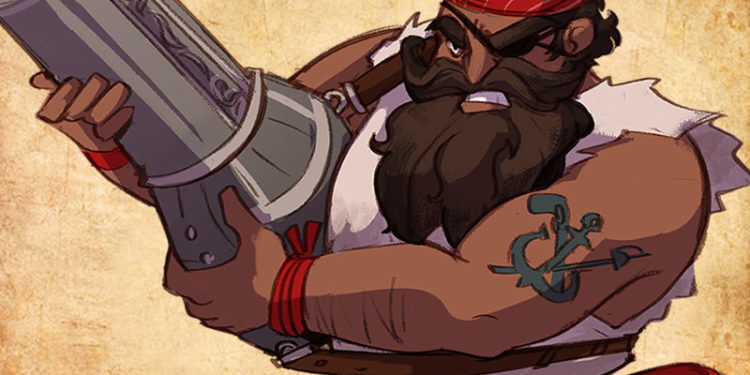Cannoneer – Fighter Archetype for 5e

I have been busy with the Vodari Kickstarter and it’s been a while since I had time to post on the Campaign Trail. I wanted to share this experiential subclass concept I’ve been toying with for seafaring campaigns. The following subclass pushes the limits on what can be done in 5e, but I think it can work and be a blast to play. The Cannoneer makes a portable cannon and explodes things, but they also experiment to find other uses for black powder (again, mostly exploding things).
Please let us know in the comments below how much you love or hate this. Even better… tell us what you think you would recommend to make this work better. Thanks!
Developer Notes
- I think this subclass can be a lot of fun, but this is a tough concept to get right. Swing too much either way and the cannoneer ends up making small little fireworks or knocking the house down.
- The Cannoneer also allows players to pick and choose what type of blasting they do focusing on damage, accuracy or whatever they think it the most important aspect to build up.
- My original plan was to make the Cannoneer a subclass of the Gunslinger, but I tried it as a fighter subclass and liked the build better. I think this works better as a fighter who decides to pick up a mini cannon (or culverin).
- The culverin has the Heavy property, but the subclass allows a PC to ignore that limit on the weapon. The idea is that a little gnome or a big goliath could both pick up the 50 pound culverin, especially considering this is 100% obviously a strength build.
- Another interesting aspect of this subclass is that the culverin fires using your Strength modifier.
- I also didn’t want a subclass that was 100% focused on combat or being on a ship, so I provided some utility with the Pyrotechnics feature.
- Finally, I’m looking at making the Cannoneer proficient with big cannons. So I’m working on how to fit a Gunner/Cannoneer into the official ‘Officers and Crew’ rules and how to apply proficiency to a siege engine such as a cannon.
Cannoneer – Fighter Archetype for 5e
The archetypal Cannoneer is a fighter who specializes in using gunpowder to devastate enemies, mixing brawn with technical know-how. Cannoneers learn to master the aiming, reloading, and firing of cannons from the decks of ships, on battlefields, or in their workshop. This specialization allows Cannoneers to blast cannonballs and other projectiles at their enemies using small cannons called culverins. A Cannoneer’s resourcefulness and expertise with gunpowder provides utility beyond the battlefield. Allowing for handy use of the explosive anywhere from the deck of a ship to the deepest depths of a dungeon.
Cannoneer Features
| Fighter Level | Feature |
| 3rd | Bonus Proficiencies, Culverin, Munitions Maker |
| 7th | Heavy Modification (2 options) |
| 10th | Pyrotechnics, Heavy Modification (3 options) |
| 15th | Advanced Ammunition, Heavy Modification (4 options) |
| 18th | Overload, Heavy Modification (5 options) |
Bonus Proficiencies
Starting at 3rd level when you choose this archetype, you gain proficiency with hand cannons and cannons. In addition, you gain proficiency with smith’s tools, or another artisan tool of your choice if you are already proficient with smith’s tools.
Culverin
When you choose this archetype, you have learned to craft a hand cannon called a culverin. You are assumed to have been collecting materials and working on your culverin for quite some time, finishing it during a short or long rest after you reach 3rd level. See “tables below” below for culverin and ammunition details. In addition:
- When you create your culverin, you start with a supply of 10 small cannonballs.
- You can create an additional culverin (or replace a lost culverin) over the course of three days of work (eight hours each day) by expending 125 gp worth of metal and other raw materials. You can maintain up to two working culverins at a time.
- Your experience and training has made you strong and steady with your culverin. You can ignore the heavy property of your culverin. In addition, being within 5 feet of a hostile creature doesn’t impose disadvantage on ranged attack rolls with your culverin.
- You can use your culverin as a two-handed melee weapon with which you are proficient, which does 1d8 bludgeoning damage.
Munitions Maker
Starting at 3rd level, with access to your smith’s tools and an open flame, you can create the following ammunition over the course of a day of work (eight hours). See “tables below” for weapons and ammunition details.
Cannonball. When you expend 5 gp worth of metal (such as iron), you can create 10 small cannonballs.
Grenado. When you expend 8 gp worth of metal (such as iron), you can create 4 grenados.
Heavy Modification
Upon reaching 7th level, you know every nook and cranny of your culverin and have made some modifications. When you gain this feature, you learn two Heavy Modification options of your choice. You gain an additional Heavy Modification option of your choice when you reach certain levels in this class: 10th, 15th, and 18th level. The options are presented here in alphabetical order.
Breaker. When making ranged attacks with your culverin using any ammunition, you ignore damage thresholds up to 15 hp.
Critical. When making ranged attacks with your culverin using cannonballs, you score a critical hit on a roll of 19-20.
Destructive. When making ranged attacks with your culverin using cannonballs, roll the damage dice of this weapon twice, and use the higher result.
Far. When making ranged attacks with your culverin using cannonballs, you now double both the normal and long range of your weapon.
Forceful. When making ranged attacks with your culverin using cannonballs, the damage type is now force.
Heavy-Duty. When making melee attacks with your culverin, you increase the damage dice to 2d6 bludgeoning.
Knockback. When you make a ranged attack with your culverin using cannonballs and hit, your target is pushed back 10 feet.
Reliable. When making ranged attacks with your culverin using cannonballs, when you roll a natural 1 on an attack roll with a hand cannon, it no longer becomes becomes jammed.
Spinning. When making ranged attacks with your culverin using cannonballs, you can now add +2 to your attack roll.
True. When making ranged attacks with your culverin using any ammunition, you can ignore half cover, and treat three-quarter cover as half cover.
Pyrotechnics
Beginning at 10th level, your knowledge of gunpowder allows you to employ this destructive black powder for more utilitarian uses. When you use 1 oz. of gunpowder and a makeshift fuse you can attempt one of the following. Once you use this feature, you can’t do so again until you finish a short or long rest.
Destroy Lock. You can combine using gunpowder and your smith’s tools to destroy a lock. You can use your proficiency in smith’s tools to pick a lock, causing a thunderous boom audible out to 100 feet. On a success, the lock is destroyed.
Destroy Trap. If a mechanism for a trap is detected, you can use your smith’s tools to destroy a trap. You can use your proficiency in smith’s tools to disarm a trap, causing a thunderous boom audible out to 100 feet. On a success, the trap is destroyed.
Fireworks. As an action, you create a firework. At the start of your next turn, a dazzling display of light, color, and sound is generated. Each creature within 5 feet of the fireworks must succeed on a DC 12 Constitution saving throw or become blinded until the end of your next turn. In addition, the fireworks persist for 1 minute, are audible out to 150 feet, can be seen from 300 feet.
Smoke. As an action, you create a device that will smoke. At the start of your next turn, thick black smoke that spreads out from you in a 20-foot radius, moving around corners. The area of the smoke is heavily obscured. The smoke persists for 1 minute or until a strong wind disperses it.
Timed Distraction. As an action, you create a noise maker that will begin making noise in 1 minute. The noise is audible from 300 feet away and last for 1 minute.
 Advanced Ammunition
Advanced Ammunition
Starting at 15th level, with access to your smith’s tools, you can create the following ammunition over the course of a day of work (eight hours). See “tables below” for ammunition details.
Explosive Canister. When you expend 10 gp worth of metal and gunpowder you can create 2 canisters filled with gunpowder.
Flashbang Canister. When you expend 10 gp worth of metal and other materials, you can create 2 flashbang canisters.
Scattershot Canister. When you expend 5 gp worth of metal and other materials, you can create 2 canisters filled with musket balls.
OVERLOAD
Beginning at 18th level, you can overload your culverin with additional gunpowder, with the intention of exploding the weapon. Roll 4d6 fire damage and then keep rolling an additional 1d6 fire damage until you roll a 1 on a die. All additional damage dice can not be re-rolled under any condition. Each creature in a 20-foot-radius sphere from the culverin must make a Dexterity saving throw. A target takes damage equal to all of the dice on a failed save, or half as much damage on a successful one. Your culverin is destroyed.
Using Hand Cannons
While hand cannons can cause more damage than other ranged weapons, they do have some unique properties and potential drawbacks that can act as a counterbalance. Here are three properties every hand cannon has.
Strength-Based. This weapon uses the Strength modifier for the attack and damage rolls for ranged attacks.
Loud. Hand cannons are loud. An attack with a hand cannon produces a loud boom that travels out from your position. If a creature is within 300 feet of you when you make the attack, that creature has advantage on Wisdom (Perception) checks against you, and you have disadvantage on Dexterity (Stealth) checks until the start of your next turn.
Misfire. When you roll a natural 1 on an attack roll with a hand cannon, it becomes jammed. A jammed hand cannon can’t be used to attack again until you use your action to unjam the weapon.
Hand Cannon Proficiencies
Only Fighters who select the Cannoneer fighter archetype at 3rd level are proficient with hand cannons.
Special Weapons
Weapons with special rules are described here.
Culverin. These hand cannons fire cannonballs (or other ammunition which will change the damage properties). To fire this weapon requires ¼ pound of gunpowder.
Grenado. Hollow ball of metal or clay fitted with a wick and filled with black powder (gunpowder). As an action, a character can light and throw a grenado at a point up to 30 feet away. Each creature within a 10-foot-radius of an exploding grenado must make a DC 12 Dexterity saving throw, taking 2d6 fire damage on a failed save, or half as much damage on a successful one.
Stinkpot. Clay jar filled with chemicals that releases noxious smoke when lit. As an action, a character can light and throw a stinkpot at a point up to 30 feet away. Each creature within a 10-foot-radius of the stinkpot must make a DC 12 Constitution saving throw or be poisoned until the start of your next turn.
Weapons
| Name | Cost | Damage | Weight | Properties |
| Simple Ranged Weapons | ||||
| Grenado | 2 gp | 2d6 bludgeoning | 2 lb. | Special |
| Stinkpot | 2 gp | 2d6 bludgeoning | 2 lb. | Special |
| Hand Cannons | ||||
| Culverin | 250 gp | 2d6 bludgeoning | 50 lb. | Ammunition (range 150/300), heavy, loading, two-handed, special |
Adventuring Gear
The Adventuring Gear table provides new and existing equipment options that fit swashbuckling and seafaring campaigns. The most commonly available gear found in the port cities around Vodari can be found on the table.
This section describes any items that have special rules or require further explanation.
Canister, Explosive. When fired from a culverin and the target is hit, the target takes normal damage and any creature within 5 feet of the target must make a Dexterity saving throw equal to 8 + your proficiency + your Strength modifier. A creature takes 2d6 fire damage on a failed save, or half damage on a success.
Canister, Flashbang. When fired from a culverin and the target is hit, the target takes normal damage and any creature within 5 feet of the target must make a Constitution saving throw equal to 8 + your proficiency + your Strength modifier. A creature is blinded and deafened on a failed save until the start of your next turn.
Canister, Scattershot. When fired from a culverin and the target is hit, the target takes normal damage and the container breaks open and musket balls spray out. Any creature within 10 feet of the target must make a Dexterity saving throw equal to 8 + your proficiency + your Strength modifier. A creature takes 1d6 bludgeoning damage on a failed save, or half damage on a success.
Adventuring Gear
| Item | Cost | Weight |
| Ammunition | ||
| Cannonball, small | 5 sp | 2 lb. |
| Canister, explosive | 10 gp | 2 lb. |
| Canister, flashbang | 10 gp | 2 lb. |
| Canister, scattershot | 5 gp | 2 lb. |
| Powder horn (20) | 2 gp | 1 lb. |
| Gunpowder, small keg | 20 gp | 10 lb. |
Artwork by Mariam Trejo



